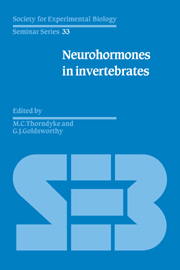Book contents
- Frontmatter
- Contents
- List of contributors
- Preface
- What is special about peptides as neuronal messengers?
- Part I Immunocytochemistry and Ultrastructure
- The new neurobiology – ultrastructural aspects of peptide release as revealed by studies of invertebrate nervous systems
- Immunocytochemistry of hormonal peptides in molluscs: optical and electron microscopy and the use of monoclonal antibodies
- Immunocytology of insect peptides and amines
- Immunocytochemistry and ultrastructure of crustacean endocrine cells
- Part II Arthropod Neurohormones
- Part III Neurohormones in Coelenterates, Annelids and Protochordates
- Part IV Neurohormones in Molluscs
- Index
Immunocytology of insect peptides and amines
Published online by Cambridge University Press: 04 August 2010
- Frontmatter
- Contents
- List of contributors
- Preface
- What is special about peptides as neuronal messengers?
- Part I Immunocytochemistry and Ultrastructure
- The new neurobiology – ultrastructural aspects of peptide release as revealed by studies of invertebrate nervous systems
- Immunocytochemistry of hormonal peptides in molluscs: optical and electron microscopy and the use of monoclonal antibodies
- Immunocytology of insect peptides and amines
- Immunocytochemistry and ultrastructure of crustacean endocrine cells
- Part II Arthropod Neurohormones
- Part III Neurohormones in Coelenterates, Annelids and Protochordates
- Part IV Neurohormones in Molluscs
- Index
Summary
In vertebrate endocrinology, significant progress has been made over the past 30 years due to the availability of immunochemical techniques. Marshall (1951) obtained the first immunohistological result in the adenohypophysis of several mammalian species using an anti-ACTH antiserum. These immunohistological investigations were made possible because of the early isolation of vertebrate hormones and neurohormones.
Invertebrate neuropeptides, however, were not purified and sequenced until more recently because of the small size of central nervous systems (CNS) or neurohaemal organs. The first invertebrate neuropeptide to be isolated was proctolin from the cockroach, Periplaneta americana (Brown & Starratt 1975). Invertebrate neurosecretory cells have however been visualized by histochemical staining methods for about forty years.
Most antibodies used in vertebrate immunocytochemistry are raised against mammalian hormones or neurohormones. They nevertheless give positive immunoreactions at the level of lower vertebrate hypophyseal and hypothalamic cells. It was tempting therefore to discover if such antisera could also generate positive results in invertebrates. The first evidence of the existence of an immunochemical relationship between vertebrate and invertebrate neuropeptides was produced in 1975 by Grimm-Jorgensen & MacKelvy. Using radioimmunoassays, they found an immunoreactive thyrotropin releasing hormone (TRH)-like substance in gastropod ganglia.
In 1977, some invertebrate neurosecretory cells synthesizing neurosecretory products related to vertebrate neuropeptides or vertebrate gastro-entero-pancreatic peptides, were visualized by immunocytochemical techniques, in earthworm ganglia (Sundler et al. 1977) and insect suboesophageal ganglia (Rémy et al. 1977). These early findings caused surprise and even scepticism among several scientists. There are now over two hundred different immunocytochemical results in this area, about seventy five of which concern insects.
- Type
- Chapter
- Information
- Neurohormones in Invertebrates , pp. 43 - 78Publisher: Cambridge University PressPrint publication year: 1988
- 3
- Cited by



